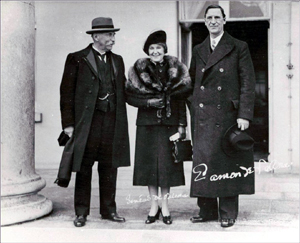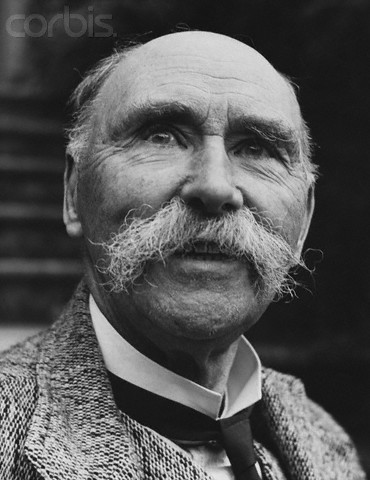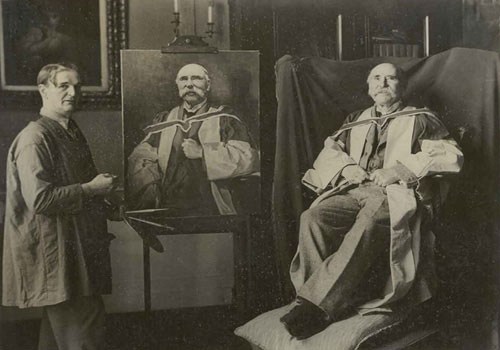<Back to Index>
- Botanist Leonhart Fuchs, 1501
- Novelist Charles Brockden Brown, 1771
- 1st President of Ireland Douglas Hyde, 1860
PAGE SPONSOR
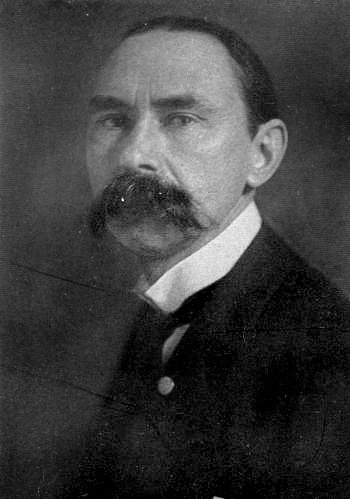

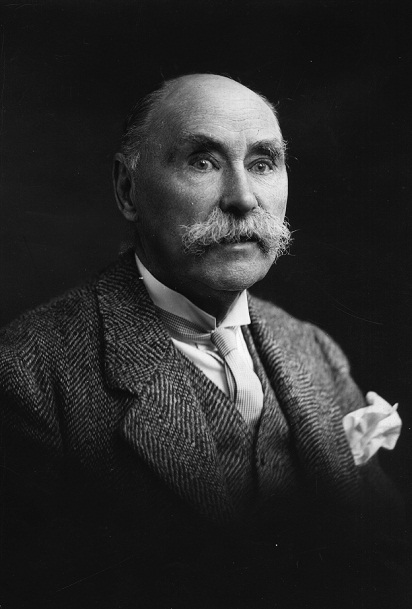
Douglas Hyde (Irish: Dubhghlas de hÍde; 17 January 1860 – 12 July 1949), known as An Craoibhín Aoibhinn ("The Pleasant Little Branch"), was an Irish scholar of the Irish language who served as the first President of Ireland from 1938 to 1945. He founded the Gaelic League, one of the most influential cultural organisations in Ireland at the time.
Hyde was born at Longford House in Castlerea in County Roscommon, while his mother, Elizabeth née Oldfield (1834 – 1886) was on a short visit there. His father, Arthur Hyde, was Church of Ireland rector of Kilmactranny, County Sligo, from 1852 to 1867, and it was here that Hyde spent his early years. Arthur Hyde & Elizabeth Oldfield married in Co. Roscommon in 1852 and had three other children, Arthur (1853 - 1879 in Co. Leitrim), John Oldfield (1854 - 1896 in Co. Dublin), and Hugh (1856) Hyde. In 1867, his father was appointed prebendary and rector of Tibohine, and the family moved to neighbouring Frenchpark, in County Roscommon. He was home schooled by his father and his aunt due to a childhood illness. While a young man he became fascinated with hearing the old people in the locality speak the Irish language. He was influenced in particular by the gamekeeper Seamus Hart and the wife of his friend, Mrs Connolly. He was crushed when Seamus Hart died (Douglas was 14) and his interest in the Irish language, which was the first language he began to study in any detail, and which was his own undertaking, flagged for a while. However, he visited Dublin a number of times and realised that there were groups of people, just like him, interested in Irish, a language looked down on at the time by many and seen as backward and old-fashioned.
Rejecting family pressure that like past generations of Hydes he follow a career in the Church, Hyde instead became an academic. He entered Trinity College, Dublin, where he became fluent in French, Latin, German, Greek and Hebrew. A medallist of The College Historical Society, he was elected its President in 1931. His passion for Irish, already a language in severe decline, led him to found the Gaelic League, or in Irish, Conradh na Gaedhilge, in the hope of saving it from extinction.
Hyde married Lucy Cometina Kurtz, a German, in 1893 and had two daughters, Nuala and Una. Hyde joined the Society for the Preservation of the Irish Language around 1880, and between 1879 and 1884 he published more than a hundred pieces of Irish verse under the pen name "An Craoibhín Aoibhinn". The
Irish language movement, initially seen as eccentric, gained a mass
following throughout the island. Hyde helped establish the Gaelic Journal in 1892, and the same year he published a pamphlet called The Necessity for De-Anglicising Ireland, arguing that Ireland should follow her own traditions in language, literature and even in dress. In 1893 he helped found the Gaelic League.
It was set up to encourage the preservation Irish culture, its music,
dances, and language. Many of the new generation of Irish leaders who
played a central role in the fight for Irish independence in the early
twentieth century, including Patrick Pearse, Éamon de Valera (who married his Irish teacher Sinéad Ní Fhlannagáin), Michael Collins, and Ernest Blythe first became politicised and passionate about Irish independence through their involvement in Conradh na Gaedhilge (Gaelic League).
His use of Irish to fill in the 1911 census form, provides a primary
source confirming his commitment to this language (Census 1911 - de
hÍde). Interestingly, his position, entered on the census form
as (Ollamh) or professor at the National University of Ireland, (and its later constituent college University College Dublin),
has been (intentionally?) mistranslated by the enumerator as "teacher".
Hyde himself, however, felt uncomfortable at the growing politicisation
of his movement (which had been infiltrated by the Irish Republican Brotherhood, just like the Irish Volunteers and the Gaelic Athletic Association) and resigned the presidency in 1915; he was replaced reluctantly by co-Founder Eoin MacNeill. Hyde had no association with Sinn Féin and the Independence movement. He did, however, accept appointment to Seanad Éireann, the upper house of the Irish Free State's Oireachtas (parliament) from his friend, the President of the Executive Council W.T. Cosgrave, after the creation of the new state. However,
his tenure was short-lived. In November 1925, the house moved from
being an appointed to an elected body. Hyde contested the election,
which was based on one state-wide constituency, but a smear by a
religious organisation, the Catholic Truth Society of Ireland, based on his supposed support for divorce (in fact he was anti-divorce) and his Protestantism, and promoted by the CTS secretary in the letters column of the Irish Independent, fatally damaged his chances and he lost his seat. He returned to academia, as Professor of Irish at University College Dublin, where one of his students was future Attorney General and President of Ireland, Cearbhall Ó Dálaigh. In April 1938, by now retired from academia, Douglas was plucked from retirement by Taoiseach Éamon de Valera and again appointed to Seanad Éireann. Again his tenure proved short, even shorter than before. But this time it was because, on the suggestion of Fine Gael, Hyde was chosen after inter-party negotiations as the first President of Ireland, to which he was elected unopposed. He was selected for a number of reasons: Both the Taoiseach, Éamon de Valera, and the Leader of the Opposition, W.T. Cosgrave, admired him; Both
wanted a president with universal prestige to lend credibility to the
new office, especially since the new 1937 Constitution made it unclear
whether the president or the British monarch was the official head of state; Both wanted to purge the humiliation that had occurred when he had lost his Senate seat in 1925; Both
wanted a president who would prove that there was no danger that the
new president would become an authoritarian dictator in Ireland, a
widespread fear when the new constitution was being discussed in 1937; Both wanted to pay tribute to Hyde's Conradh na Gaeilge role in achieving Irish independence; Both wanted to choose a non-Catholic to disprove the assertion that the State was a "confessional state". Hyde was inaugurated as the first President of Ireland on 26 June 1938, in the first inaugural ceremony in the nation's history. In
the evening there was a ceremony in Dublin Castle which was without
precedent in Irish history. Mr. and Mrs. de Valera received about 1,500
guests at a reception in honour of the President. The reception was
held in St. Patrick's Hall, where the banners of the Knights of St.
Patrick are still hung. The attendance included all the members of the
Dail and Senate with their ladies, members of the Judiciary and the
chiefs of the Civil Service, Dr. Paschal Robinson, the Papal Nuncio at
the head of the Diplomatic Corps, several Roman Catholic Bishops, the
Primate of All Ireland, the Archbishop of Dublin, the Bishop of
Killaloe, the heads of the Presbyterian and Methodist congregations,
the Provost and Vice Provost of Trinity College, and the President of
the National University. It was the most colourful event that has been
held in Dublin since the inauguration of the new order in Ireland, and
the gathering, representing as it did every shade of political,
religious, and social opinion in Eire [Ireland], might be regarded as a
microcosm of the new Ireland. Hyde
set a precedent of reciting the Presidential Declaration of Office in
Irish (though the president is technically permitted to choose
English). His recitation, in his native Roscommon Irish dialect,
remains one of the few recordings of a dialect that has long
disappeared and of which Hyde himself was one of the last speakers. Upon inauguration, he moved into the long vacant Viceregal Lodge in Phoenix Park, since known as Áras an Uachtaráin ("Residence
of the President"). Despite
being placed in a position to shape the office of the presidency via
precedent, Hyde by and large opted for a quiet, conservative
interpretation of the office. His age and (after a paralysing stroke in
April 1940) deteriorating health obligated him to schedule periods of
rest throughout his days, and his lack of political experience caused
him to defer to his advisers on questions of policy and discretionary
powers, especially to his Secretary, Michael McDunphy. Hyde, with his
handlebar mustache and warm personality, was a popular president.
United States President Franklin D. Roosevelt called
President Hyde a "fine and scholarly old gentleman", while President
Hyde and King George V corresponded about stamp collecting. However
in April 1940 he suffered a massive stroke. Plans were made for his
lying-in-state and state funeral, but to the surprise of everyone he
survived, albeit paralysed and having to use a wheelchair. Although
the role of President of Ireland was, and is, largely ceremonial, Hyde
did have a small number of important decisions to make during his
presidency. He was confronted with a crisis in 1944 when de Valera's
government unexpectedly collapsed in a vote on the Transport Bill and the President had to decide whether or not to grant an election to de Valera. (He granted the election.) President Hyde also twice used his power under Article 26 of the Constitution, having consulted the Council of State, to refer a Bill or part of a Bill to the Supreme Court,
for the court's decision on whether the Bill or part referred is
repugnant to the Constitution (so that the Bill in question cannot be
signed into law). On the first occasion, the court held that the Bill
referred - Offences Against the State (Amendment) Bill, 1940 - was not
repugnant to the Constitution. In
response to the second reference, the Court decided that the particular
provision referred - section 4 of the School Attendance Bill, 1942 -
was repugnant to the Constitution. Because
of Article 34.3.3° of the Constitution, the constitutional validity
of the Offences Against the State (Amendment) Act, 1940 cannot be challenged in any court, since the Bill which became that Act was found by the Supreme Court not to be repugnant in the context of an Article 26 reference. One of Hyde's last presidential acts was a visit to the German ambassador Eduard Hempel on 3 May 1945 to offer his condolences on the death of Adolf Hitler. The visit remained a secret until 2005.
Hyde
left office on 25 June 1945, opting not to nominate himself for a
second term. Due to his ill-health he did not return to his Roscommon home Ratra,
which had lain empty since the death of his wife early in his term.
Instead he was moved into the former Secretary to the Lord Lieutenant's
residence in the grounds of Áras an Uachtaráin, which he
renamed Little Ratra and where he lived out the remaining four years of his life. He died quietly at 10pm on 12 July 1949, aged 89.
As a former President of Ireland he was accorded a state funeral. A problem arose; as a member of the Church of Ireland his funeral service took place in Dublin's Church of Ireland St. Patrick's Cathedral. However, contemporary rules of the Roman Catholic Church in Ireland prohibited
Roman Catholics from attending services in non-Catholic churches. As a
result all but one member of the Catholic cabinet, Dr. Noel Browne,
remained outside the cathedral grounds while Hyde's funeral took place.
They then joined the cortège when his coffin left the cathedral.
Éamon de Valera, by now Leader of the Opposition also did not
attend, being represented by a senior Fianna Fáil figure who was a member of the Church of Ireland, Erskine Childers,
a future President of Ireland himself. Hyde was buried in Frenchpark,
County Roscommon at Portahard Church, (where he had spent most of his
childhood life) beside his wife Lucy, his daughter Nuala, his sister Annette, mother Elizabeth and father Arthur.
In 2000 Gaelscoil de hÍde was set up in Roscommon town. Currently 120 students attend the school. His
father's old church is now a museum dedicated to showing memorabilia
about Douglas Hyde, the Church of Ireland squire who took up the cause
of the Irish language and ended up as the first President of Ireland. Coláiste de hÍde, a Gaelcholáiste (all-Irish secondary level college) was founded in 1993 in Tallaght, South Dublin, in his honour. A picture as well as a collection of his books originally written in Irish are on display in the school's new building in Tymon North Park, Tallaght. Dr. Hyde Park is the home of Roscommon GAA. Opened in 1969 it has a capacity of 30,000. It hosts many championship matches due to Roscommon's geographical positioning. The Douglas Hyde Gallery is located in Trinity College, Dublin. It was opened in 1978 and it is home to many contemporary art exhibitions.
“ In
the morning [Dr Hyde] attended a service in St. Patrick's Cathedral
presided over by the Archbishop of Dublin, Dr. Gregg. Mr. de Valera and
his Ministerial colleagues attended a solemn Votive Mass in the
Pro-Cathedral, and there were services in the principal Presbyterian
and Methodist churches, as well as in the synagogue. Dr. Hyde was
installed formally in Dublin Castle, where the seals of office were
handed over by the Chief Justice. Some 200 persons were present,
including the heads of the Judiciary and the chief dignitaries of the
Churches. After the ceremony President Hyde drove in procession through
the beflagged streets. The procession halted for two minutes outside
the General Post Office to pay homage to the memory of the men who fell
in the Easter Week rebellion of 1916. Large crowds lined the streets
from the Castle to the Vice-Regal Lodge and the President was welcomed
with bursts of cheering. He wore morning dress, but Mr. de Valera and
Mr. Sean T. O'Kelly, who followed Dr. Hyde in the next motor car, wore
black clothes with felt hats. ”
